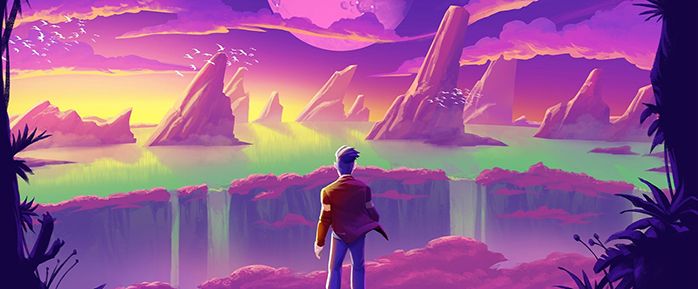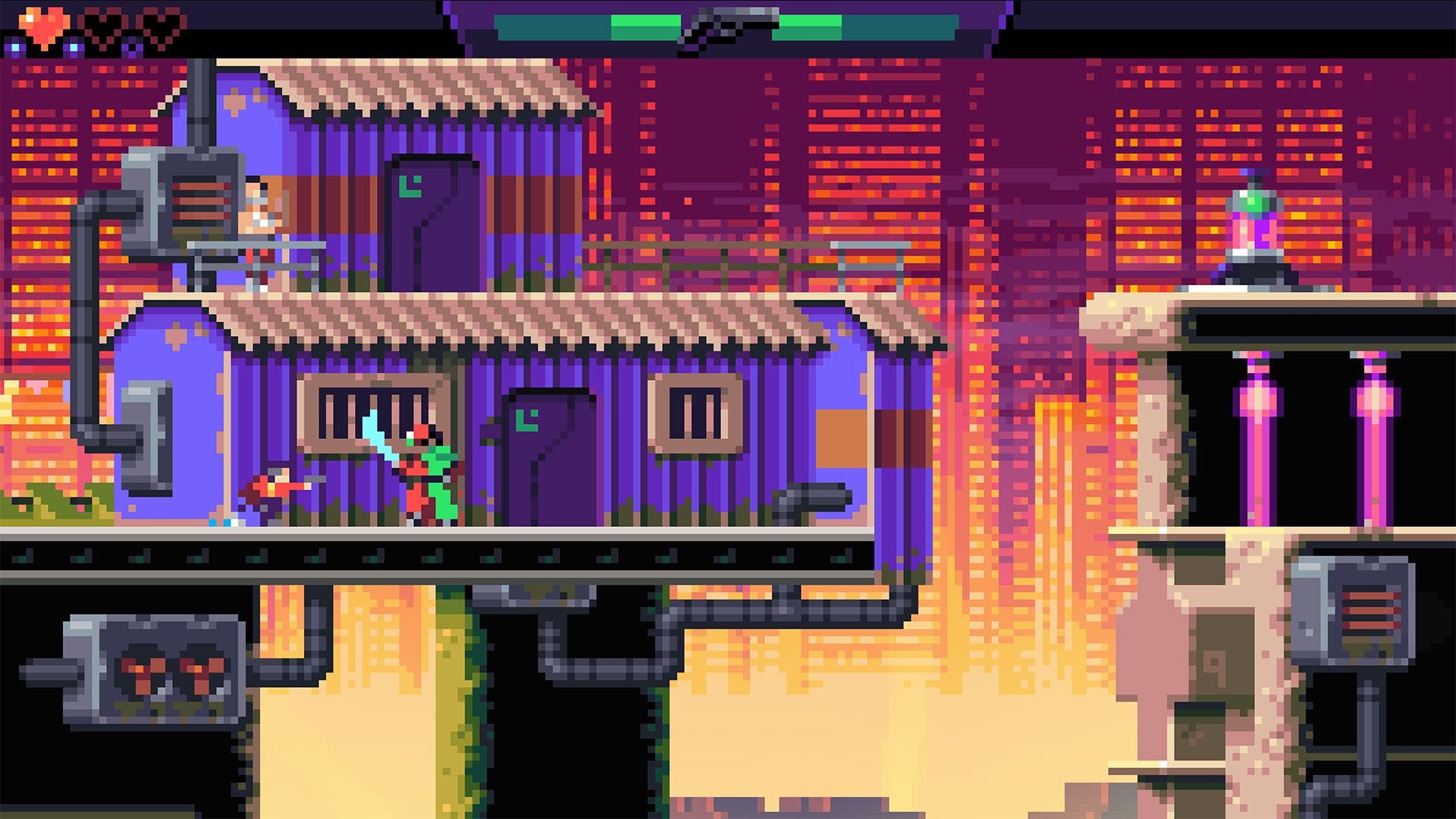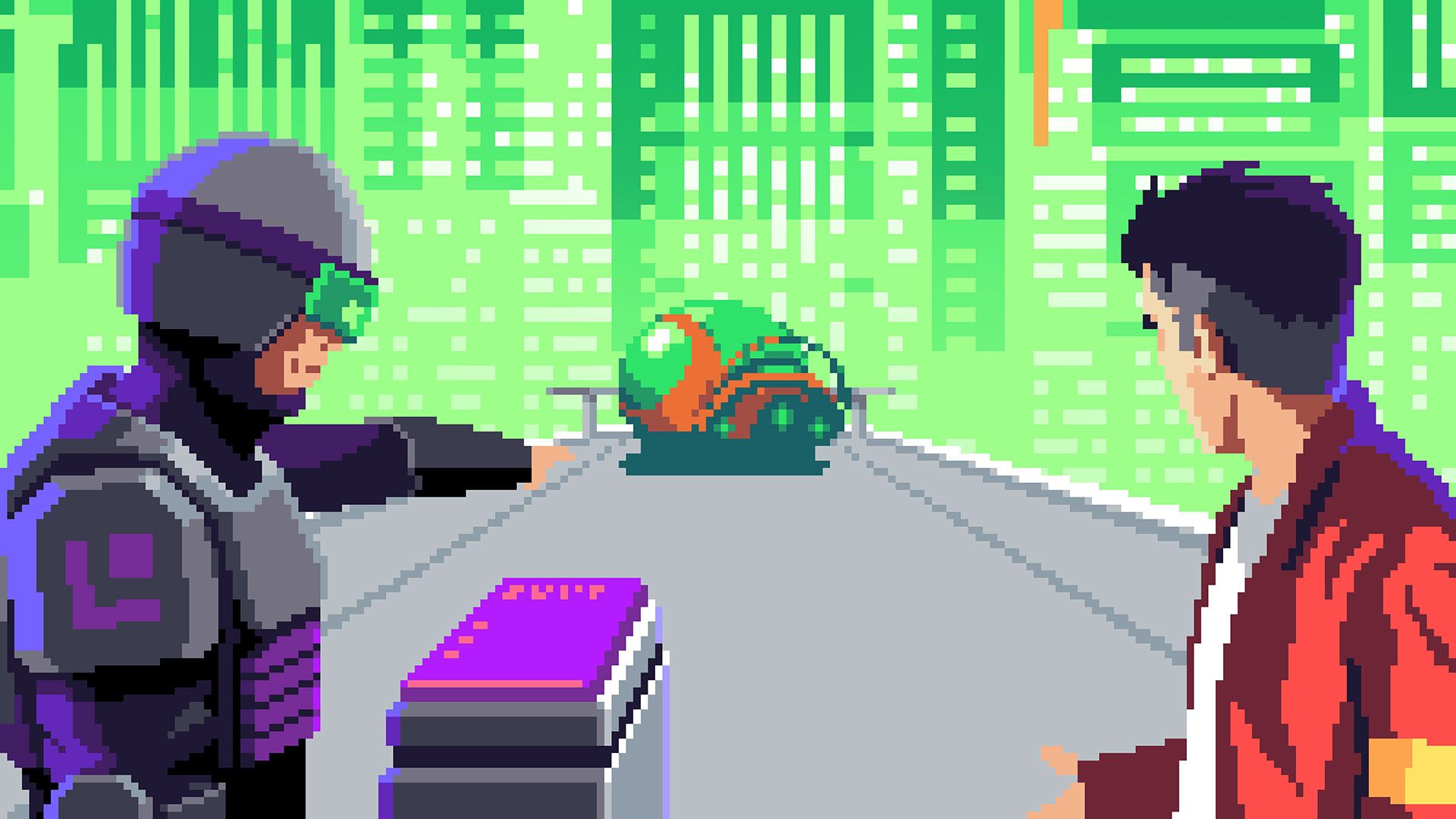Somewhere on a distant planet is humanity's new home, ruled over by a government that doesn't seem so bad unless you catch its attention. Leo had the bad fortune to be the prime suspect in a bombing and is now on the run, first to get away and eventually to learn the secrets of his planet's past. He's going through all this, however, in a platformer sub-genre that's only got a small handful of games despite its pedigree, not to mention an art style that uses a low resolution to present its world. Lunark is the kind of game that leaves one wondering how it all came together, and sole developer Johan Vinet was kind enough to answer a small pile of questions about its creation.
[Hardcore Gamer] LUNARK has been in development for several years now. How has the game evolved since its initial creation to now?
[Johan Vinet] Things like the story and the number of levels and cutscenes were fairly well defined very early on. It was during the development, level by level, that I gradually addressed the remaining unknowns such as the size of the levels, the exact number of NPCs and their dialogue, the puzzles, and the enemies that the game would contain.
Regardless of its rather long development time, LUNARK did not go through any drastic rethinking or change of direction. There were certainly a lot of tweaks regarding the controls during the first year of development, and a few added features like weapon upgrades, the ability to engage in close-range combat, and minor graphical improvements like adding a projected shadow to the sprites, but overall, the creation of the game followed a rather linear path, I would say.
Fifteen pixels tall isn't a lot of room for character design. What kind of challenges did you face designing and animating at this super-pixely resolution?
I knew that creating a game with such a low resolution would have as many advantages as disadvantages. Pros: Creating assets (backgrounds, objects, portraits) was faster. Cons: Bringing richness and life to sprite animations was trickier. Fortunately, working with this kind of extreme constraint is my favorite challenge. Indeed, when a pixel is equivalent to 10 centimeters high, it is impossible to make people raise their eyebrows or even open their mouths, so it is a matter of finding other ways to make your characters expressive by figuring out which movements to exaggerate without looking too cartoonish.
Another challenge was the text readability. To solve this problem, I actually multiplied the resolution of the game by two to be able to display more detailed fonts.
Cinematic platformers somehow ended up with a very specific type of movement, but also a specific type of level design to work with it. What kind of adjustments did you make to put your own spin on it?
Good question. I spent a lot of time on this aspect of the game's development and, honestly, I could have spent even more. Now that we have lots of buttons on our controllers, my first decision was to assign the forward jump and roll to dedicated ones. Complicated thumb movements may be acceptable for special moves in a fighting game, but not really for such basic actions with today’s expectations.
I also tried to make the controls more reactive, which is quite challenging in a classic cinematic platformer where most of the animations have to end before the next one begins, which can contribute to this feeling of input delay.
To help with this, I reduced the distance required between each jump opportunity, and made the character automatically turn to face a ledge when climbing up or down with faster animations. You’ll be able to shoot without drawing your weapon beforehand, and you'll instantly re-holster it as soon as you start walking or running. When you’re rolling with your gun and you hit a wall, there’s a good chance you’re being chased by an enemy, so Leo will automatically turn around, ready to shoot, and if you walk towards a cliff, Leo will stop and hesitate (once!) if the fall is going to be fatal. You’ll also be able to remap your buttons to some extent.
I had other ideas, but if I had tried all of those, development would still be ongoing! I hope that the result will satisfy both purists and new players who discover the genre with LUNARK.
The initial Kickstarter estimated about a year of production, and while deadlines are generally best thought of as wishful thinking, it's still been maybe a bit longer than expected. What kind of development challenges (or other roadblocks) have you encountered along the way?
I knew I was very optimistic when I announced one year of development but I had no idea it was going to be four.
While working alone has its advantages (you save time in communication, don't have to justify your choices or make concessions, and the project follows a single vision from start to finish), it was very difficult for me to plan my tasks properly. This was especially true with programming. I’m an artist at heart, and this was my first commercial game as a programmer. Luckily, partway through production I was able to recruit the talents of Topher Anselmo, who was able to address the most critical elements under the hood so I could focus on the gameplay.
Also, the process of creating those rotoscoped scenes was really time consuming! I tried various techniques to optimize the workflow as much as possible, but the core of the technique still relies on laborious manual work.
And finally, who would have predicted that I would lose several months of productivity taking care of my children 24/7 because of a global pandemic?
Also from the Kickstarter, the initial plan was to go full indie. How did you end up bringing LUNARK to Wayforward?
Indeed, I originally intended to self-publish, mainly because I didn't see what a publisher could bring to such a small project. Then, over the course of months and years, I made contact with a few major publishers - which didn't work out - but that convinced me that the game could appeal to a wider audience than I had imagined.
Finally, the closer I got to the finish line, the more I realized that I didn't really want to handle the marketing, and when Adam Tierney reached out about publishing LUNARK, it didn't take long for me to accept. I had already worked for WayForward as an animator and knew that LUNARK would not only be in good hands, but that they would be able to get it in front of a larger audience of pixel-art and neo-retro game enthusiasts.
You've shared some of the live-action to animation rotoscoping for the cutscenes on social media. Did you also use this for the in-game animations or was it designed by hand?
Almost all of the in-game animations are hand-animated. I used rotoscoping for a handful of them, like when Leo goes up and down the stairs or when he respawns. However, outside of rotoscoping, I did use videos of myself as reference for several animations, like the close-range combat and stopping in front of a cliff. This is a common practice among animators.
There's a whole lot of Mœbius peeking out from behind LUNARK. What other inspirations have you drawn on for the story and world?
Definitely a lot of different things: Total Recall, Akira, Blade Runner, The Expanse, Altered Carbon, Indiana Jones, Back to the Future… I also realized recently that LUNARK was basically Avatar? Anyway, I wanted LUNARK to be colorful and vivid; this is not a game where I want people to feel visually oppressed. I want them to have a good time in a pretty world they’d like to be part of.
Cinematic platformers are few and far between. Was there anything specific about this tiny little sub-genre that made you decide to wrap LUNARK around it?
It was this genre that - first with Prince of Persia and Another World/Out of this World - made me realize what a great medium video games were for the aspiring creative that I was. I loved classic platformers, but all of a sudden I had proof that it was also possible to offer a cinematic and immersive aspect that had never been seen before in this medium. Then Flashback, Oddworld, and many others came along, before being replaced by their successors in 3D like the fantastic Tomb Raider, Uncharted, and others.
Even if we have seen heirs of this genre like Inside or, more recently, Somerville or Planet of Lana, I wanted to pay tribute in my own way to these cult titles that influenced me during my youth.
https://www.anrdoezrs.net/links/3607085/type/dlg/sid/UUhgUeUpU7839/https://www.youtube.com/watch?v=FIPxGGZif_g




